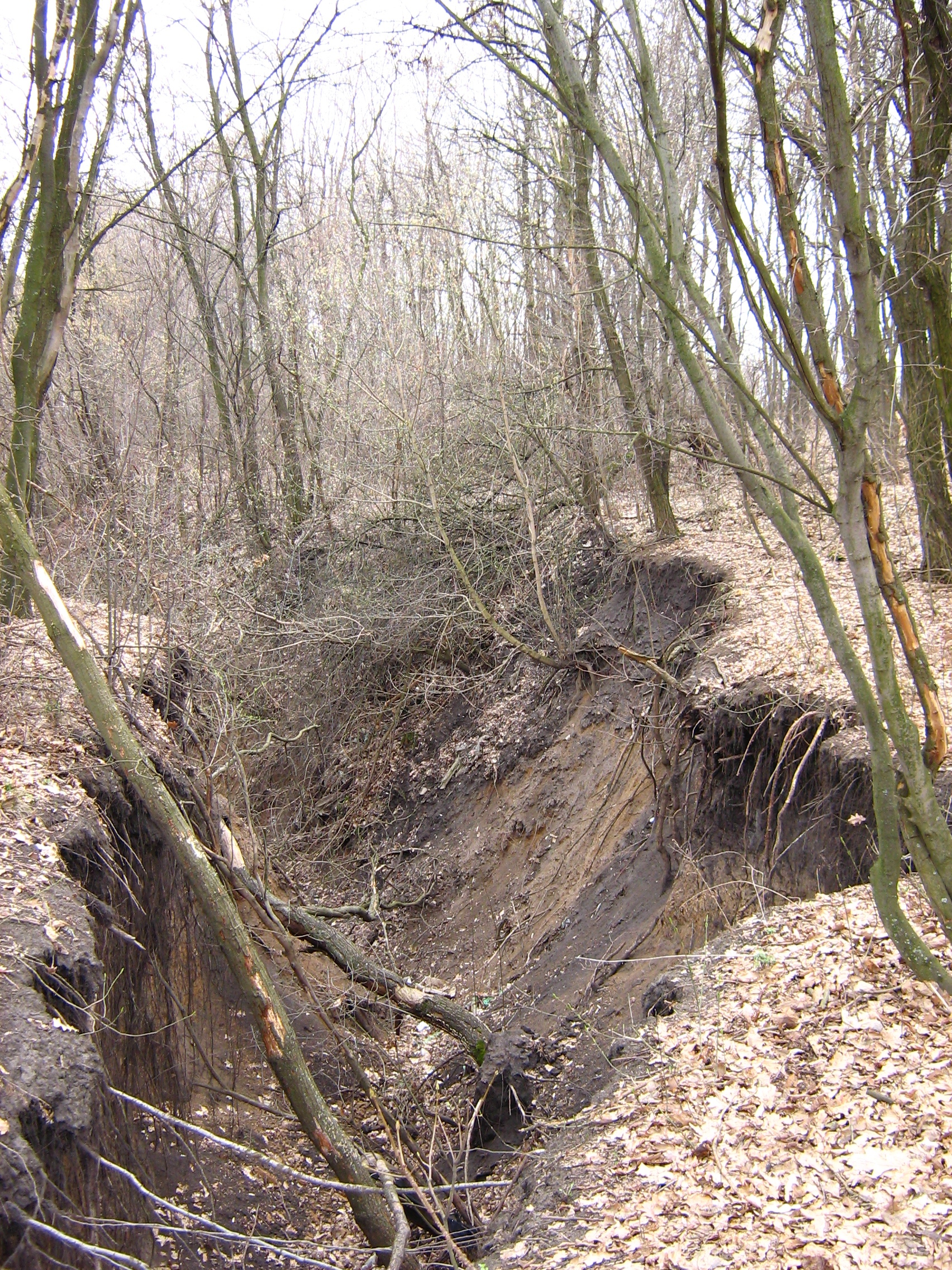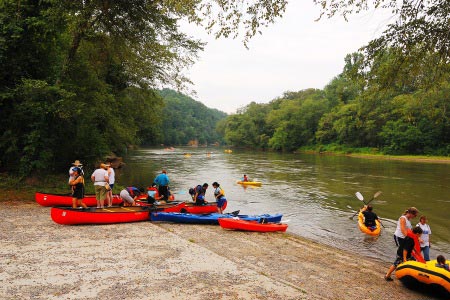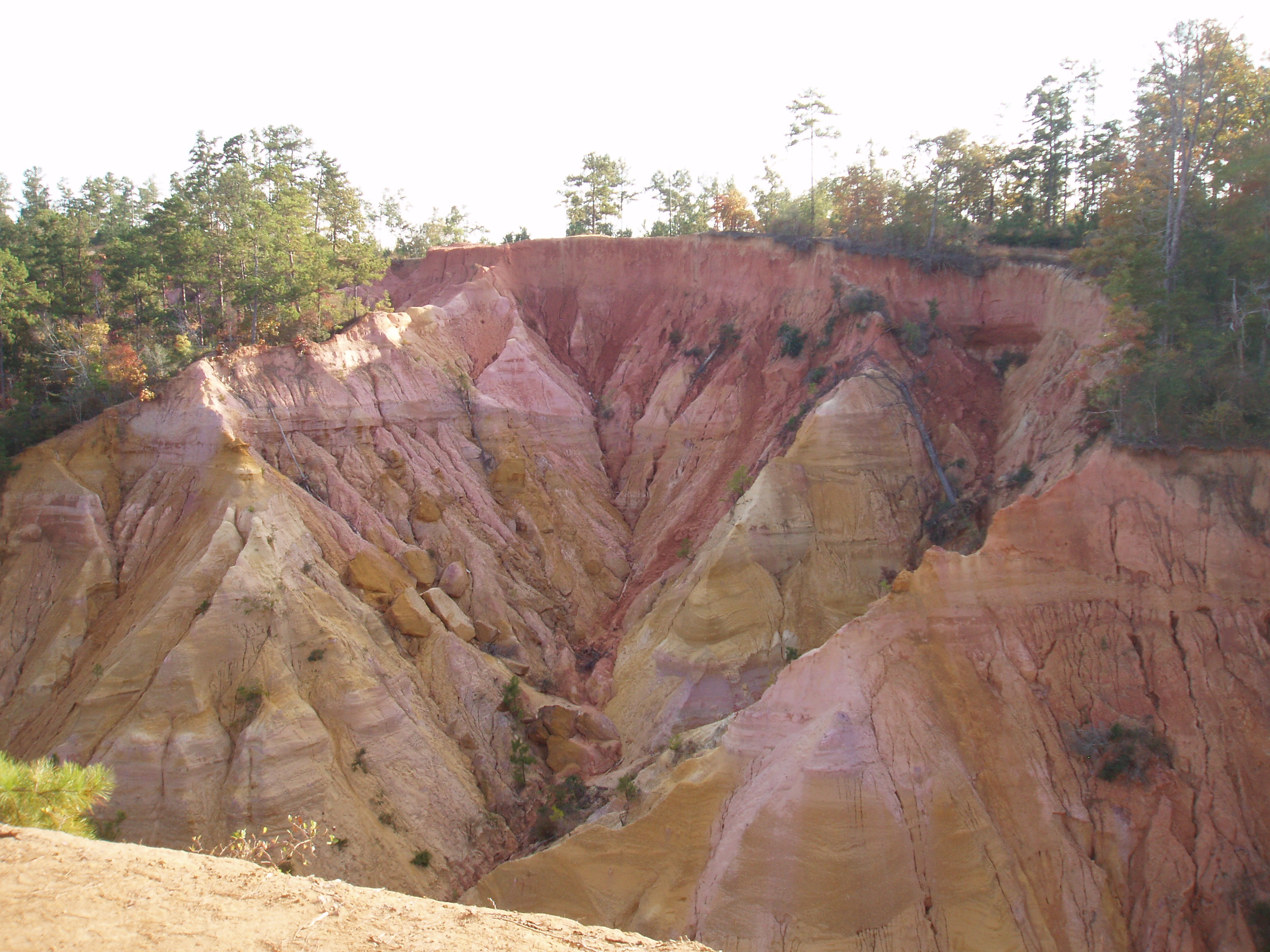|
Providence Canyon State Park
Providence Canyon State Outdoor Recreation Area is a Georgia state park located in Stewart County in southwest Georgia, United States. The park contains Providence Canyon, which is sometimes called Georgia's "Little Grand Canyon". It is considered one of the Seven Natural Wonders of Georgia. It is also home to the very rare plumleaf azalea. One of the quirkier attractions of the state park is an abandoned homestead including nearly a dozen rusty, 1950s-era cars and trucks. Due to the environmental damage that removing the vehicles would cause, park officials have decided to leave them alone. Canyon formation Providence Canyon is not actually a purely natural feature—many of the massive gullies —the deepest of which is more than — are the result of erosion due to poor farming practices in the 19th century. This story of the origin of the canyons has been commonplace since the 1940s, but the formations in the canyons are at least partially natural. Although there were ... [...More Info...] [...Related Items...] OR: [Wikipedia] [Google] [Baidu] |
List Of Georgia State Parks
This is a list of state parks in Georgia. The park system of the US state of Georgia was founded in 1931 with Indian Springs State Park and Vogel State Park. Indian Springs has been operated by the state as a public park since 1825, making it perhaps the oldest state park in the United States. The newest state park is Don Carter State Park. Since the economic crash of 2008, Georgia has halved the budget for the Division of State Parks and Historic Sites and turned over the management of five of the parks to Coral Hospitality, a Florida-based hotel and resort management company. The five parks are Amicalola Falls State Park & Lodge, Unicoi State Park & Lodge, Little Ocmulgee State Park & Lodge, Georgia Veterans State Park, and George T. Bagby State Park. State parks Historic sites Former state parks Other *Lake Lanier Islands were leased from the US Army Corps of Engineers by the Georgia Department of State Parks for a recreation resort. The islands are now managed b ... [...More Info...] [...Related Items...] OR: [Wikipedia] [Google] [Baidu] |
Stewart County, Georgia
Stewart County is a county located in the west central portion of the U.S. state of Georgia. As of the 2010 census, the population was 6,058. The county seat is Lumpkin. The county was created on December 23, 1830. History The area was inhabited by Native Americans for thousands of years in the Pre-Columbian period. Roods Landing site on the Chattahoochee River is a significant archaeological site located south of Omaha. Listed on the National Register of Historic Places, it includes major earthwork mounds built about 1100-1350 CE by peoples of the sophisticated Mississippian culture. Another Mississippian site is the Singer Moye Mounds, located in the southern part of the county. The first Europeans to encounter the Native Americans were Spanish explorers in the mid-16th century. At that time the historical Creek tribe inhabited the southern two thirds of what is now defined as Georgia, west of the Low Country. they are believed to be the descendants of the Mississipp ... [...More Info...] [...Related Items...] OR: [Wikipedia] [Google] [Baidu] |
Georgia (U
Georgia most commonly refers to: * Georgia (country), a country in the Caucasus region of Eurasia * Georgia (U.S. state), a state in the Southeast United States Georgia may also refer to: Places Historical states and entities * Related to the country in the Caucasus ** Kingdom of Georgia, a medieval kingdom ** Georgia within the Russian Empire ** Democratic Republic of Georgia, established following the Russian Revolution ** Georgian Soviet Socialist Republic, a constituent of the Soviet Union * Related to the US state ** Province of Georgia, one of the thirteen American colonies established by Great Britain in what became the United States ** Georgia in the American Civil War, the State of Georgia within the Confederate States of America. Other places * 359 Georgia, an asteroid * New Georgia, Solomon Islands * South Georgia and the South Sandwich Islands Canada * Georgia Street, in Vancouver, British Columbia, Canada * Strait of Georgia, British Columbia, Canada United K ... [...More Info...] [...Related Items...] OR: [Wikipedia] [Google] [Baidu] |
Grand Canyon
The Grand Canyon (, yuf-x-yav, Wi:kaʼi:la, , Southern Paiute language: Paxa’uipi, ) is a steep-sided canyon carved by the Colorado River in Arizona, United States. The Grand Canyon is long, up to wide and attains a depth of over a mile (). The canyon and adjacent rim are contained within Grand Canyon National Park, the Kaibab National Forest, Grand Canyon–Parashant National Monument, the Hualapai Indian Reservation, the Havasupai Indian Reservation and the Navajo Nation. President Theodore Roosevelt was a major proponent of the preservation of the Grand Canyon area and visited it on numerous occasions to hunt and enjoy the scenery. Nearly two billion years of Earth's geological history have been exposed as the Colorado River and its tributaries cut their channels through layer after layer of rock while the Colorado Plateau was uplifted. [...More Info...] [...Related Items...] OR: [Wikipedia] [Google] [Baidu] |
List Of The Seven Natural Wonders Of Georgia (U
A ''list'' is any set of items in a row. List or lists may also refer to: People * List (surname) Organizations * List College, an undergraduate division of the Jewish Theological Seminary of America * SC Germania List, German rugby union club Other uses * Angle of list, the leaning to either port or starboard of a ship * List (information), an ordered collection of pieces of information ** List (abstract data type), a method to organize data in computer science * List on Sylt, previously called List, the northernmost village in Germany, on the island of Sylt * ''List'', an alternative term for ''roll'' in flight dynamics * To ''list'' a building, etc., in the UK it means to designate it a listed building that may not be altered without permission * Lists (jousting), the barriers used to designate the tournament area where medieval knights jousted * ''The Book of Lists'', an American series of books with unusual lists See also * The List (other) * Listing (di ... [...More Info...] [...Related Items...] OR: [Wikipedia] [Google] [Baidu] |
Plumleaf Azalea
''Rhododendron prunifolium'', the plumleaf azalea, is a wild azalea that grows only in a few counties along the Georgia–Alabama border in the Chattahoochee River Valley. It is considered the rarest azalea in the Eastern United States. Providence Canyon is one of the most popular places to view the plumleaf azalea in the wild. References External linksThe Nature Conservancy Rhododendron, prunifolium Plants described in 1913 Flora of North America {{Ericaceae-stub ... [...More Info...] [...Related Items...] OR: [Wikipedia] [Google] [Baidu] |
Gully
A gully is a landform created by running water, mass movement, or commonly a combination of both eroding sharply into soil or other relatively erodible material, typically on a hillside or in river floodplains or terraces. Gullies resemble large ditches or small valleys, but are metres to tens of metres in depth and width and are characterised by a distinct 'headscarp' or 'headwall' and progress by headward (i.e. upstream) erosion. Gullies are commonly related to intermittent or ephemeral water flow usually associated with localised intense or protracted rainfall events, or snowmelt. Gullies can be formed and accelerated by cultivation practices on hillslopes (often gentle gradient) in farmland, and they can develop rapidly in rangelands from existing natural erosion forms subject to vegetative cover removal and livestock activity. Etymology The earliest known usage of the term is from 1657. It originates from the French word ''goulet'', a diminutive form of ''goule'' which m ... [...More Info...] [...Related Items...] OR: [Wikipedia] [Google] [Baidu] |
Treaty Of Indian Springs (1825)
The Treaty of Indian Springs, also known as the Second Treaty of Indian Springs and the Treaty with the Creeks, is a treaty concluded between the Muscogee and the United States on February 12, 1825 at what is now the Indian Springs Hotel Museum. Background The Muscogee and the United States had signed the First Treaty of Indian Springs in 1821, under which the former ceded their territory east of the Flint River to Georgia. In exchange, the federal government of the United States paid them $200,000 in installments and assumed their debts to the Georgian people. In December 1824, the American envoys Duncan Campbell and James Meriwether tried and failed to secure a treaty that would see the Muscogee cede their territory east of the Mississippi River to the United States. The treaty The treaty that was agreed was negotiated with six chiefs of the Lower Creek, led by William McIntosh. McIntosh agreed to cede all Muscogee lands east of the Chattahoochee River, including t ... [...More Info...] [...Related Items...] OR: [Wikipedia] [Google] [Baidu] |
Creek People
The Muscogee, also known as the Mvskoke, Muscogee Creek, and the Muscogee Creek Confederacy ( in the Muscogee language), are a group of related indigenous (Native American) peoples of the Southeastern WoodlandsTranscribed documents Sequoyah Research Center and the American Native Press Archives in the . Their original homelands are in what now comprises southern , much of , western |
Chattahoochee River
The Chattahoochee River forms the southern half of the Alabama and Georgia border, as well as a portion of the Florida - Georgia border. It is a tributary of the Apalachicola River, a relatively short river formed by the confluence of the Chattahoochee and Flint Flint, occasionally flintstone, is a sedimentary cryptocrystalline form of the mineral quartz, categorized as the variety of chert that occurs in chalk or marly limestone. Flint was widely used historically to make stone tools and start fir ... rivers and emptying from Florida into Apalachicola Bay in the Gulf of Mexico. The Chattahoochee River is about long. The Chattahoochee, Flint, and Apalachicola rivers together make up the Apalachicola–Chattahoochee–Flint River Basin (ACF River Basin). The Chattahoochee makes up the largest part of the ACF's drainage basin. Course The River source, source of the Chattahoochee River is located in Jacks Gap at the southeastern foot of Jacks Knob, in the very southeaste ... [...More Info...] [...Related Items...] OR: [Wikipedia] [Google] [Baidu] |
Red Bluff (Mississippi Landmark)
Red Bluff (colloquially known as Mississippi's Little Grand Canyon) is a natural geologic feature, located in Marion County, Mississippi, located about 1.5 miles northwest of the community of Morgantown.''Morgantown, Mississippi,'' 7.5 Minute Topographic Quadrangle, USGS, 1970 Geologic description Red Bluff is a geological formation created by the natural erosion of the west bank of the Pearl River. The bluff is an exposure red clay, soil, sand, and other colorful sediments''Mississippi'' by Marlo Carter Kirkpatrick (pg. 179) and rises to an elevation of approximately 371 feet above . The bluff slopes sharply (200&nb ... [...More Info...] [...Related Items...] OR: [Wikipedia] [Google] [Baidu] |
Canyons And Gorges Of Georgia (U
A canyon (from ; archaic British English spelling: ''cañon''), or gorge, is a deep cleft between escarpments or cliffs resulting from weathering and the erosive activity of a river over geologic time scales. Rivers have a natural tendency to cut through underlying surfaces, eventually wearing away rock layers as sediments are removed downstream. A river bed will gradually reach a baseline elevation, which is the same elevation as the body of water into which the river drains. The processes of weathering and erosion will form canyons when the river's headwaters and estuary are at significantly different elevations, particularly through regions where softer rock layers are intermingled with harder layers more resistant to weathering. A canyon may also refer to a rift between two mountain peaks, such as those in ranges including the Rocky Mountains, the Alps, the Himalayas or the Andes. Usually, a river or stream carves out such splits between mountains. Examples of mountain-type c ... [...More Info...] [...Related Items...] OR: [Wikipedia] [Google] [Baidu] |


.jpg)



